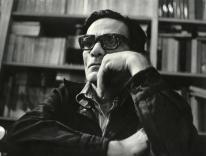David Kepesh, the hero of Elegy, Isabel Coixet’s adaptation of Philip Roth’s The Dying Animal, is on a long sabbatical from intimacy. A professor and minor literary star in New York, he’s estranged from his son, the only child of a marriage that ended in a bitter divorce. He deems his more attractive female students fair game, but in-season only after final exams. Once Kepesh sleeps with the desired one, it’s Cole Porter time again: “No strings and no connections / No ties to my affections...”
But then David (Ben Kingsley) meets Consuela (Penélope Cruz), the beautiful daughter of exiles from Castro’s Cuba. Though living on her own and free to enjoy Manhattan’s treats, Consuela has the inner restraint and aristocratic carriage of a lady in a Velásquez portrait. It’s as if she had an invisible dueña by her side; in fact, she is her own dueña. That really turns Kepesh on, and he settles for some long-term wooing. But even after he’s been sexually satisfied, he can’t break away. Not sex alone but the force of Consuela’s emotions has subjugated him, and this is a catastrophe for the old satyr. He wants her to be his forever, but her forever may last forty or fifty years. His will be...rather shorter. Her tenderness has made him terribly aware that he is a dying animal.
Isabel Coixet’s great strength as a director is her tactile rendering of passionate sex. She makes you feel the sensory overload of love. For decades it’s been common for the camera to crawl into bed with screen lovers, but Coixet isn’t satisfied with mere horizontal calisthenics. Her close-ups of the faces of the lovers make it clear that a life-changing experience is underway.
Yet viewers may receive even more of a buzz from the erotic passages between Kepesh and his long-term, middle-aged mistress Carolyn (Patricia Clarkson), though both insist that their sex is just physical and convenient. This is a matter not of staging or physique, but of the characterizations of the two women in Nicholas Meyer’s script. Meyer has done a skillful job of rendering the Roth book as a chamber drama for five characters (Kepesh, his two lovers, his best friend, and his son), but while he writes Caroline as mettlesome, spiky, and by turns gracious and demanding, Consuela comes across as too muted, too much the fulfillment of a male’s dream. True, she is, like so many upper-middle-class Cuban girls, a product of a courtly, conservative upbringing, but she is also supposed to have depths that Kepesh longs to sound. Cruz is perfectly cast for looks and manner, but the temperament she displayed in Almodóvar’s Volver and Woody Allen’s latest film (below) could have contributed something valuable to this story. “We’re so dazzled by the outside [of lovely women],” remarks David’s poet friend George, “that we never see the inside.” This may be true of David, but it is also sadly true of the script’s failure to see inside Consuela. Patricia Clarkson, on the other hand, is given a range of emotions to explore, and she projects a sizzling sexuality precisely because it’s only one aspect of a complex personality.
I also wish that Coixet and Meyer had shown us more of the New York literary world that Philip Roth writes so well, and scathingly, about. (The recent film Starting Out in the Evening does a better job of that.) If we could have seen David bumping up against editors, critics, media people, fans, and rivals, we might have felt even more keenly the fizz that Kepesh might be reluctant to exchange for the responsibilities of love.
But it’s a meaty role as it is, and Ben Kingsley makes the most of it. Sometimes a little too showy with his vocal effects (sudden accelerations and fortissimos) but just as often subtle and quietly moving, the actor gives us a compelling portrait of the book-chat artist as an old dog. And as his reasonable best friend, Dennis Hopper (Hopper as the voice of reason!), tackles a part that never gives him a chance to kill, rape, maim, scream, take personality-altering drugs, pillage or burn, and yet is completely, touchingly convincing. Who’d have guessed?
One of the few good things about growing old is that you get sick of yourself. Change seems imperative if you are not to rot. And if you are an artist, the urge to change may keep you from resorting to old tricks that have begun to bore.
Woody Allen has never shunned the task of reinventing himself. For him, self-reinvention often entails a change of mentors. After his early successes, with their comically dithering dialogues, he undertook graver films that were not only inspired by, but practically quoted Fellini (Stardust Memories) and Bergman (Interiors, Another Woman). For me, the European visuals functioned more as uncomfortable overlays than as authentic realizations of the scripts. In his later efforts, Allen achieved authenticity whenever he rang variations on American genres rather than looking toward Europe: Everyone Says I Love You as a deliberately klutzy version of Hollywood musicals, Manhattan Murder Mystery as an affectionate take on the Thin Man series.
Now, in Vicky Cristina Barcelona, Allen again turns to Europeans—to Éric Rohmer and François Truffaut—for artistic permission to achieve something new for him: the sunset glow of a skeptical, compassionate old age. And this time the European influence works nicely. The hilarity of Allen’s early work has been toned down, and this story’s eroticism (which might have been intensely rendered by a younger director like Coixet) is here merely sketched in as revolving heads on a pillow. But no matter: the film so quickly and deftly establishes its wry, smiling tone that you don’t ask for anything stronger but simply enjoy what’s offered.
In Barcelona (city of eternal vacation) two American tourists—the soon-to-be-married Vicky (Rebecca Hall), working on a doctoral dissertation, and the perpetually wavering Cristina (Scarlett Johansson), a frustrated artist—are approached by a well-regarded and sybaritic painter, Juan Antonio (Javier Bardem, as sleepily confident here in the role of a lothario as he was as a killing machine in No Country for Old Men) to take part in a three-way tryst with him. Vicky is outraged; her pal is intrigued. Circumstances throw both women into the company of the would-be seducer, but never do all three get together in the bedroom. When Juan Antonio’s tempestuous ex-wife reappears (Penélope Cruz again, this time exuding her usual brio), a three-way does take place but not the one Juan Antonio originally had in mind.
The actions, settings, and characterizations are very Rohmeresque: as in Claire’s Knee and Pauline at the Beach, we see young, spiritually unsettled people coming to terms with their natures while on holiday. Their bodies are supposed to be relaxing but their minds are going into a tailspin. Accordingly, Allen has carried over some of Rohmer’s stylistic ways: the sunny photography, the relaxed pace that allows conversations to unfold from beginning to end, the attentiveness to the speakers’ faces, the expressions often telling us so much more than the talk.
From Truffaut’s Two English Girls and Jules and Jim, Allen has lifted the device of an off-screen narrator whose rapid, rather emotionless delivery fills in the banal interstices of the story (why the girls are in Barcelona and who is hosting them, how much time is passing, etc.) so that the important encounters don’t need to be encumbered by exposition.
Why does Rohmer prove more fruitful a model for Allen than Bergman and Fellini? Well, to be Felliniesque you have to be the irreplaceable Italian himself, and it’s silly to be Bergmanesque when you’re telling stories set in crowded, voluble New York. (Bergman doesn’t exist in places where there isn’t any silence.) But a neurotic, witty American can be just as much himself while chattering at a café table as a Frenchman can. Both Allen and Rohmer like their antagonists to be nonstop talkers; both have obvious affection for their characters even as they mock them; both invent stories to support their dialogues rather than the other way round (though Rohmer usually concludes his films with a neat, O. Henry plot twist while Allen often, as here, simply runs out of gas). Besides, Rohmer’s shots, though precise enough, aren’t virtuosic displays of idiosyncratic genius. So Allen can borrow from his visual style without looking slavishly imitative.
But observe one big difference: Rohmer, a Catholic concerned (however entertainingly) with free will and moral striving, usually invents a climax in which the hero chooses to do or not to do something, and thereby grows spiritually. But Vicky Cristina concludes by showing that all the main characters must simply fall back into their old ways. People generally don’t change in a Woody Allen movie; they just find their proper levels.
Related: Rand Richards Cooper reviews Allen's film Match Point
Robert E. Lauder interviews Woody Allen: Whatever Works
Please email comments to [email protected] and join the conversation on our Facebook page.
Share
Previous Story
The Making of a Bishop
Next Story
The First Cold Warrior?


